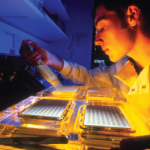SAN FRANCISCO—By harnessing the power of next generation sequencing strategies and combining them with clever statistical strategies and tools, investigators are striving to define causal pathways of and mechanisms underlying complex diseases, such as rheumatoid arthritis, according to Soumya Raychaudhuri, MD, PhD, associate professor, Harvard Medical School, Brigham and Women’s Hospital, Boston, during a session on Next Generation Sequencing: A Novel Tool for Genomic Discovery at the 2015 ACR/ARHP Annual Meeting.

Dr. Raychaudhuri
In the session, Dr. Raychaudhuri was one of three panelists to speak on current investigative activity into the use of next generation sequencing to understand complex diseases. Such sequencing is used to target the discovery of rare variants in the genome to better understand complex trait diseases, such as rheumatoid arthritis (RA). More recently applied genome-wide association studies (GWAS) query common variants; with this strategy, causal alleles and mutations are difficult to ascertain, due to the many linkages among these variants, which doesn’t permit isolating one variant from the other to truly know what is causal or not. In contrast, rare variants more readily lead to understanding causation given that these rare variants often are not linked to nearby variants.
“Common variants have been around for a long time and have risen to a common frequency, and whatever functional potential they may be conferring has been whittled away by evolution,” said Dr. Raychaudhuri, saying that rare variants are more recently derived and, therefore, have not been purified by forces of negative selection.
“If rare variants can be identified, ascribing function can often be more clear,” he said.
The panel described current work underway using next generation sequencing strategies to identify rare variants associated with inflammatory diseases.
Mapping Rare Variants
To illustrate the power and principles of rare variant discovery, Dr. Raychaudhuri described research he and his colleague, Johanna Seddon, MD, professor of ophthalmology, Tufts Medical Center, Boston, and other collaborators have undertaken using next generation sequencing in which they successfully identified a rare haplotype associated with age-related macular degeneration (AMD). This rare haplotype was discovered by first phasing together known common variants of AMD and using the phased genotype data to identify rare and high risk haplotypes. Further study showed an association between people who had this rare haplotype and a risk of developing AMD, an association thought unlikely to be from chance alone.
To see if they could identify a rare, more clearly functional variant that might explain the risk associated with this rare haplotype, the investigators used next generation sequencing to sequence the entire gene encoding complement factor H (CFH) region in 84 people representing all 11 haplotypes. They found that the association of the haplotype was explained by a single rare mutation (R1210C) in CFH that links the pathophysiology of AMD to aHUS. People with this mutation are at high risk of developing AMD.1
Further study to define the role of rare variants in the risk of developing advanced AMD revealed an additional loss of function in C3 and CFI variants that, when linked with CFH, deactivates C3 in AMD.2 These data further show the direction of effect and mechanism of action underlying AMD.
To date, however, mapping rare variants for rheumatoid arthritis has not yet met with much success, said Dr. Raychaudhuri, adding that rare variant discovery in RA is more difficult than other autoimmune diseases.
Ongoing RA sequencing work by his group and by collaborators in the RA genetics community includes sequencing individuals with a high risk of disease burden. This includes sequencing individuals with RA who also have a sibling with RA, and patients with early onset disease or early age at onset of disease.
He said that further work will require larger sample sizes for adequately powered studies. “These studies will hopefully bring about novel discoveries in RA genetics and pathogenesis,” he said.
Discovery of Novel Disease

Dr. Aksentijevich
“Discovery of new disease-causing genes in rare patients may point to new pathways regulating immune and inflammatory responses,” said Ivona Aksentijevich, MD, staff scientist, Inflammatory Disease Section, National Institutes of Health, National Human Genome Research Institute, Bethesda, Md., in her presentation in which she shared work underway showing that whole exome sequencing (WES) can be used to identify novel disease-causing genes in both familial and sporadic cases with systemic inflammatory diseases.
As one type of next generation sequencing strategies, WES is a powerful and cost-effective tool—and one that works much faster than conventional approaches—to dissect the genetic basis of Mendelian phenotypes, or monogenic diseases, such as autoinflammatory diseases.
“New sequencing technologies along with new bioinformatic tools and the access to publicly available databases that provide exome sequences from over 100,000 human exomes allow identification of disease-causing genes in patients that present as sporadic cases, and that would otherwise be challenging for gene discoveries,” she said.
Illustrating the power of this next generation sequencing strategy, she highlighted nine new autoinflammatory diseases that have been discovered in the past two years (2014–2015) using WES, whereas it took 15 years (1997–2013) to identify 13 autoinflammatory diseases using conventional genetic approaches.
Despite the rapid increase in discovery of autoinflammatory diseases with the use of WES, she emphasized that many patients remain undiagnosed because of limitations with WES (captures only 80–90% of coding sequences, 5’ end of transcripts are typically poorly covered, and copy-number variations are not detected).
In addition, she said that somatic mutations can be missed with WES and evidence increasingly shows the importance of these mutations for pathogenesis of disease, particularly late-onset disease.
Finally, she emphasized the need for collaboration to narrow down the list of candidate genes. “It is very important to work together when it comes to patients with rare inflammatory disease,” she said. “We should share data from our patients and collaborate in pursing new gene discoveries.”
Lung Involvement
As one example of collaboration in looking for rare variants associated with rheumatic diseases, Tony Shum, MD, assistant professor, Pulmonary & Critical Care, Cardiovascular Research Institute, University of California San Francisco, spoke on work underway to better understand the role of the lung in systemic autoimmunity.

Dr. Shum
He spoke on research in which he and his colleagues used WES to map rare variants in families with autoimmune arthritis with a dominant lung phenotype. They found that a rare variant, coatomer subunit alpha (COPA), was ubiquitously expressed in these patients. As a subunit of coat protein complex I (COPI), COPA enables protein transport between the Golgi and endoplasmic reticulum.3
Further research showed that mutations in the WD40 COPA domain cause autoimmune-associated lung and joint disease and identified a novel vesicular trafficking defect as the cause of autoimmunity. Their research also identified a novel molecular link between ER stress and the generation of immunity.
Prior to this research, no diseases were associated with COPA or COPI. As such, Dr. Shum said that this research points to the discovery and definition of a new syndrome, called the COPA syndrome, in which patients have pulmonary hemorrhage, interstitial lung disease and arthritis with or without autoantibodies.
Given the link between endoplasmic reticulum stress with both lung disease and the generation of immunity, further research is underway focusing on trying to understand the role of endoplasmic reticulum stress in the lung epithelium and how it may be involved more broadly in systemic autoimmunity.4,5
Dr. Shum said that this research supports emerging evidence on the importance of the lung “not only as a disease manifestation of autoimmunity but really as the tissue site in which autoimmunity might be proliferated or propagated.”6
“I think the way for clinicians to think about this is [as confirmation] of the need to tell their patients that they should not smoke, the rationale being that the lung may play a role in precipitating overall disease,” he said.
Mary Beth Nierengarten is a freelance medical journalist based in St. Paul, Minn.
References
- Raychaudhuri S, Lartchouk O, Chin K, et al. A rare penetrant mutation in CFH confers high risk of age-related macular degeneration. Nat Genet. 2011;43(12):1232–1236.
- Seddon JM, Yu Y, Miller EC, et al. Rare variants in CFI, C3 and C9 are associated with high risk of advanced aged-related macular degeneration. Nat Genet. 2013;45(11):1366–1370.
- Watkin LB, Jessen B, Wiszniewski T, et al. COPA mutations impair ER-Golgi transport and cause hereditary autoimmune-mediated lung disease and arthritis. Nat Genet. 2015;47:654–660.
- Tanjore H, Blackwell TS, Lawson WE. Emerging evidence for endoplastic reticulum stress in the pathogenesis of idiopathic pulmonary fibrosis. Am J Physiol Lung Cell Mol Physiol. 2012;302:L721–L729.
- Todd DJ, Lee AH, Glimcher LH. The endoplasmic reticulum stress response in immunity and autoimmunity. Nat Rev Immunol. 2008;8:663–674.
- Klareskog L, Stolt P, Lundberg K, et al. A new model for an etiology of rheumatoid arthritis: smoking may trigger HLA-DR (shared epitope)-restricted immune reactions to autoantigens modified by citrullination. Arthritis Rheum. 2006;54:38-46.

